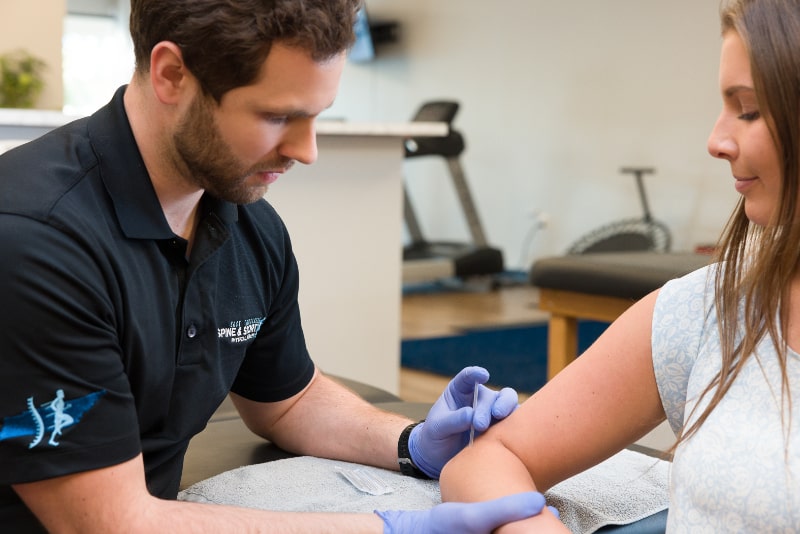East Tennessee Spine & Sport is your go-to provider of
Dry Needling Services in Knoxville, TN.
When a therapist performs dry needling, he or she uses a small needle under the skin to target tight points within a tissue that produce or refer pain. Very broadly, it is a form of instrument-assisted manual therapy, which allows practitioners access to tissues which would not be readily available for manipulation with the hands. Dry needling is similar to acupuncture, but is very different at the same time.
Acupuncture has been practiced for thousands of years and is based on a more eastern approach to medicine, while dry needling in a newer approach to treating trigger points and is based on a western approach to medicine.
Dry needling is also only a part of a physical therapy treatment. It is used with other manual techniques, exercises, and modalities such as heat or ice. Many therapists who utilize dry needling refer to it as a “tool on their tool belt.” This simply means it is part of a therapist’s broader plan of care for improving the quality of life of their patients.
Dry needling is mainly based on the work of Dr. Janet Travell and Dr. David Simons as well as Dr. Chan Gunn, who developed theories and published works based on trigger point research and intramuscular stimulation. They believed these trigger points were the cause of many patients’ chronic and long lasting pain. The exact mechanism behind trigger point occurrence, as well as the mechanism behind why dry needling works, is still unknown, although a growing body of evidence confirms that it does work.
Physical therapists are musculoskeletal experts and are the most qualified to perform dry needling. Physical therapists have always been heavily trained in musculoskeletal interventions, and as the education level has progressed to a doctorate degree, the number of clinicians who have been exposed to dry needling is growing. On top of graduating with a physical therapy degree, the number of continuing education hours to perform dry needling on patients varies state to state, ranging from 40 hours to as many as 100 continuing education hours. The focus on continuing education makes dry needling a safe treatment for physical therapists to perform.
Some common pathologies that dry needling is used to treat include trigger points, headaches, carpal tunnel syndrome, lateral epicondylitis (tennis elbow), plantar fasciitis, radiculopathy, and neck and back pain. Treating these conditions and more from a therapist who is trained in dry needling is an easy and safe addition to a plan of care and will speed recovery and return to function of patients.
Adding dry needling to a plan of care is an excellent way to treat a variety of conditions many people face on a regular basis. When performed by a trained physical therapist, this treatment technique is safe and efficient, with minimal adverse effects. Talk to your physical therapist to see if you are a candidate for this treatment and about adding this to your plan of care to further address your symptoms and speed your recovery to full function.
"*" indicates required fields

Learn about our other services we offer.
Patient Testimonials
I have used East Tennessee Spine and Sport for their MedX program and other matters such as post knee surgery, a shoulder injury, and other senior arthritic matters, since 2005. I am so grateful to have ETSS as a regular part of my health program.Ann Rust MedX Treatment
Spine and Sport's training method has shown steady results and given me the confidence so that I can return to a high level of competition. Their knowledge and expertise of back injury rehabilitation is unrivaled in the Knoxville area.Fred Smith Discectomy at L5-S1
Spine and Sport is the ultimate place for therapy. Every single therapist is highly knowledgeable and more than caring. They brought me back from my ACL tear in five months without post-op pain. Actually, I’m stronger than I was before my injury.Eleni Georgiafandis ACL Injury
Thanks to the folks who work at East Tennessee Spine and Sport, I was able to avoid surgical intervention using their program. Through their knowledgeable staff, I learned how to get well and and how to maintain the level of wellness I achieved in their clinic.Greg Peck Motorcycle Injury
In addition to my personal experience, I’ve referred my wife and several friends to ETSS. They have invariably been pleased with their results. These are good people who know their business. If your problem can be cured by physical therapy, they’ll cure you.Frank Koon Ruptured Disk
Greg DeFilippo, fellow therapists, and employees are the best! Not only are they kind and friendly, but you receive the most comprehensive care in a comfortable atmosphere. In all my experience with therapy, their expertise is unequaled!Sharon Bowles Therapy Treatment
Visit any of our 7 clinics and
